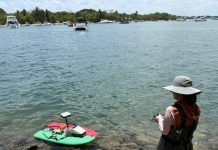Hurricane Irma showed FIU botanist Oscar Valverde-Barrantes something he does not often get to see.
All across The Kampong, trees were laying on the ground. A banyan tree that formed an archway over the entrance to the botanical garden was sheared away. The top two-thirds of a sorrowless tree, one of the biggest in the United States, was on the ground. A baobab tree, planted in 1928 by original estate owner and botanist David Fairchild, was leveled. Nearly 260 of the facility’s 600 trees were brought down or damaged by the hurricane’s strong winds and heavy rains. Valverde-Barrantes was particularly interested in the trees with roots exposed above ground.
The scientist in FIU’s International Center for Tropical Botany at The Kampong (ICTB) studies the relationship between roots and fungi in tropical plants. Both rely on each other for nutrients, and plants depend on fungi for water and disease protection. Valverde-Barrantes is trying to improve the way fertilizers are used.
“Sampling roots, particularly the finest part of the root system, in big trees is complicated,” Valverde-Barrantes said. “Seeing the exposed roots of some of the trees that were knocked down by the hurricane allowed me to collect samples of nearly 35 species, analyze them and preserve them for future studies.”
After initial data collection, Valverde-Barrantes was among a large group of volunteers and The Kampong staff who worked long hours to save the trees that had fallen and recover other plants that were damaged. Hurricane Irma’s impacts appear to be far worse than that of Hurricanes Andrew in 1992 and Wilma in 2005, according to The Kampong Director Craig Morell. One reason is because Irma was a large storm. Another is because it was a slower moving storm and effects were felt for 12 hours. Yet nearly all of the trees have a fighting chance because of swift action by staff, students and community volunteers, according to Christopher Baraloto, director of ICTB.
“The Kampong’s living collections are essential for research. It’s also an important part of our local community’s history and culture,” Baraloto said. “As unfortunate as Hurricane Irma’s damage is, the situation will hopefully bring the community together to work closer.”

Morell says the botanical garden will need to rebuild damaged landscape areas and repair irrigation and electrical systems. They will replace the plants that were lost using propagated plants that were sent elsewhere.
“The Kampong’s recovery will be much like the recovery of someone who was in a serious car accident,” Morell said. “It’ll need triage for the first month, critical care for the next six months and up to five years of rehab and therapy. It’s going to take time, money and a lot of work, but The Kampong is resilient. It’ll recover.”
Volunteers are still needed to assist with clean-up and recovery efforts. They must be at least 18 years-old and able to do physical labor. To learn how to help, email tropics@fiu.edu.






